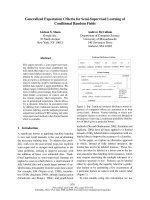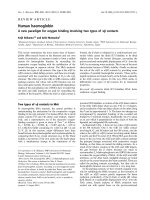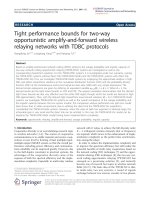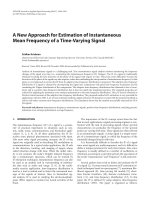Báo cáo toán học: "Two new criteria for comparison in the Bruhat order" pot
Bạn đang xem bản rút gọn của tài liệu. Xem và tải ngay bản đầy đủ của tài liệu tại đây (76.32 KB, 4 trang )
Two new criteria for comparison in the Bruhat order
Brian Drake, Sean Gerrish, Mark Skandera
Dept. of Mathematics, Brandeis University
MS 050, P.O. Box 9110, Waltham, MA 02454
Dept. of Mathematics, University of Michigan
2074 East Hall, Ann Arbor, MI 48109-1109
Dept. of Mathematics, Dartmouth College
6188 Bradley Hall, Hanover, NH 03755-3551
Submitted: Sep 25, 2003; Accepted: Jan 20, 2004; Published: Mar 31, 2004
MR Subject Classifications: 15A15, 05E05
Abstract
We give two new criteria by which pairs of permutations may be compared in
defining the Bruhat order (of type A). One criterion utilizes totally nonnegative
polynomials and the other utilizes Schur functions.
The Bruhat order on S
n
is often defined by comparing permutations π = π(1) ···π(n)
and σ = σ(1) ···σ(n) according to the following criterion: π ≤ σ if σ is obtainable from π
by a sequence of transpositions (i, j)wherei<jand i appears to the left of j in π.(See
e.g. [7, p. 119].) A second well-known criterion compares permutations in terms of their
defining matrices. Let M(π) be the matrix whose (i, j) entry is 1 if j = π(i) and zero
otherwise. Defining [i]={1, ,i}, and denoting the submatrix of M(π) corresponding
to rows I and columns J by M(π)
I,J
,wehavethefollowing.
Theorem 1 Let π and σ be permutations in S
n
. Then π is less than or equal to σ in the
Bruhat order if and only if for all 1 ≤ i, j ≤ n − 1, the number of ones in M(π)
[i],[j]
is
greater than or equal to the number of ones in M(σ)
[i],[j]
.
(See [1], [2], [3], [6, pp. 173-177], [8] for more criteria.) Using Theorem 1 and our defining
criterion we will state and prove the validity of two more criteria.
Our first new criterion defines the Bruhat order in terms of totally nonnegative poly-
nomials. A matrix A is called totally nonnegative (TNN) if the determinant of each
square submatrix of A is nonnegative. (See e.g. [5].) A polynomial in n
2
variables
f(x
1,1
, ,x
n,n
) is called totally nonnegative (TNN) if for each TNN matrix A =(a
i,j
)
the electronic journal of combinatorics 11 (2004), #N6 1
the number f(a
1,1
, ,a
n,n
) is nonnegative. Some recent interest in TNN polynomials is
motivated by problems in the study of canonical bases. (See [10].)
Theorem 2 Let π and σ be two permutations in S
n
. Then π is less than or equal to σ
in the Bruhat order if and only if the polynomial
x
1,π(1)
···x
n,π(n)
− x
1,σ(1)
···x
n,σ(n)
(1)
is totally nonnegative.
Proof: (⇒)Ifπ = σ then (1) is obviously TNN. Suppose that π is less than σ in the
Bruhat order. If π differs from σ by a single transposition (i, j)withi<j,thenwehave
π(i)=σ(j) <π(j)=σ(i), and the polynomial (1) is equal to
x
1,π(1)
···x
n,π(n)
x
i,π(i)
x
j,π(j)
(x
i,π(i)
x
j,π(j)
− x
i,π(j)
x
j,π(i)
)(2)
which is clearly TNN. If π differs from σ by a sequence of transpositions, then the poly-
nomial (1) is equal to a sum of polynomials of the form (2) and again is TNN.
(⇐) Suppose that π is not less than or equal to σ in the Bruhat order. By Theorem 1
we may choose indices 1 ≤ k, ≤ n − 1 such that M(σ)
[k],[]
contains q + 1 ones and
M(π)
[k],[]
contains q ones. Now define the matrix A =(a
i,j
)by
a
i,j
=
2ifi ≤ k and j ≤ ,
1 otherwise.
It is easy to see that A is TNN, since all square submatrices of A have determinant equal
to 0, 1, or 2. Applying the polynomial (1) to A we have
a
1,π(1)
···a
n,π(n)
− a
1,σ(1)
···a
n,σ(n)
= −2
q
,
and the polynomial (1) is not TNN.
Our second new criterion defines the Bruhat order in terms of Schur functions. (See
[9, Ch. 7] for definitions.) Any finite submatrix of the infinite matrix H =(h
j−i
)
i,j≥0
,
where h
k
is the kth complete homogeneous symmetric function and h
k
= 0 for k<0, is
called a Jacobi-Trudi matrix. Let us define a polynomial in n
2
variables f(x
1,1
, ,x
n,n
)
to be Schur nonnegative (SNN) if for each Jacobi-Trudi matrix A =(a
i,j
) the symmetric
function f(a
1,1
, ,a
n,n
) is equal to a nonnegative linear combination of Schur functions.
Some recent interest in SNN polynomials is motivated by problems in algebraic geome-
try [4, Conj. 2.8, Conj. 5.1].
Theorem 3 Let π and σ be permutations in S
n
. Then π is less than or equal to σ in the
Bruhat order if and only if the polynomial
x
1,π(1)
···x
n,π(n)
− x
1,σ(1)
···x
n,σ(n)
(3)
is Schur nonnegative.
the electronic journal of combinatorics 11 (2004), #N6 2
Proof: (⇒)Ifπ = σ then (3) is obviously SNN. Let A be an n × n Jacobi-Trudi
matrix and suppose that π is less than σ in the Bruhat order. If π differs from σ by
a single transposition (i, j), then for some partition ν and some k, ,m (, m > 0), the
evaluation of the polynomial (3) at A is equal to
h
ν
(h
k+
h
k+m
− h
k++m
h
k
), (4)
and (3) is clearly SNN. If π differs from σ by a sequence of transpositions, then the
evaluation of (3) at A is equal to a sum of polynomials of the form (4) and again (3) is
SNN.
(⇐) Suppose that π is not less than or equal to σ in the Bruhat order. By Theorem 1 we
may choose indices 1 ≤ k, ≤ n − 1 such that M(σ)
[k],[]
contains q + 1 ones and M(π)
[k],[]
contains q ones. Now define the nonnegative number r =(k−q)(n+k−−2) and consider
the Jacobi-Trudi matrix B defined by the skew shape (n − 1+2r)
k
(n − 1+r)
n−k
/r
,
B =
h
n−1+r
··· h
n+−2+r
h
n+−1+2r
··· h
2n−2+2r
.
.
.
.
.
.
.
.
.
.
.
.
h
n−k+r
··· h
n−k+−1+r
h
n−k++2r
··· h
2n−k−1+2r
h
n−k−1
··· h
n−k+−2
h
n−k+−1+r
··· h
2n−k−2+r
.
.
.
.
.
.
.
.
.
.
.
.
h
0
··· h
−1
h
+r
··· h
n−1+r
.
The polynomial (3) applied to B may be expressed as h
λ
− h
µ
for some appropriate
partitions λ, µ depending on π, σ, respectively. We claim that λ is incomparable to or
greater than µ in the dominance order. Since M(π)
[k],[+1,n]
contains k − q ones we have
that
λ
1
+ ···+ λ
k−q
≥ (k − q)(n − k + +2r). (5)
Similarly, we have
µ
1
+ ···+ µ
k−q
≤ (k − q − 1)(2n − 2+2r)+max{n + − 2+r, 2n − k − 2+r}. (6)
Subtracting (6) from (5), we obtain
(λ
1
+ ···+ λ
k−q
) − (µ
1
+ ···+ µ
k−q
) ≥ n − max{, n − k} > 0,
as desired.
Recall that the Schur expansion of h
µ
is
h
µ
= s
µ
+
ν>µ
K
ν,µ
s
ν
,
where the comparison of partitions ν>µis in the dominance order and the nonnegative
Kostka numbers K
ν,µ
count semistandard Young tableaux of shape ν and content µ.
(See e.g. [9, Prop. 7.10.5, Cor. 7.12.4].) It follows that the coefficient of s
µ
in the Schur
expansion of h
λ
− h
µ
is −1 and the polynomial (3) is not SNN.
The authors are grateful to Sergey Fomin, Zachary Pavlov, Alex Postnikov, Christophe
Reutenauer, Brendon Rhoades, Richard Stanley, John Stembridge, and referees for helpful
conversations.
the electronic journal of combinatorics 11 (2004), #N6 3
References
[1] A. Bj
¨
orner. Orderings of Coxeter groups. In Combinatorics and Algebra
(C. Greene, ed.), vol. 34 of Contemp. Math American Mathematical Society, Prov-
idence, RI, 1984 pp. 175–195.
[2] A. Bj
¨
orner and F. Brenti. An improved tableau criterion for Bruhat order.
Electron. J. Combin., 3 (1996). Research paper 22, 5 pp. (electronic).
[3] V. Deodhar. Some characterizations of Bruhat ordering on a Coxeter group and
determination of the relative M¨obius function. Inventiones Math., 39 (1977) pp.
187–198.
[4] S. Fomin, W. Fulton, C. Li, and Y. Poon. Eigenvalues, singular values, and
Littlewood-Richardson coefficients, 2003. Preprint math.AG/03013078 on ArXiv.
[5] S. Fomin and A. Zelevinsky. Total positivity: Tests and parametrizations. Math.
Intelligencer, 22 (2000) pp. 23–33.
[6] W. Fulton. Young Tableaux; With Applications to Representation Theory and Ge-
ometry,vol.35ofLondon Mathematical Society Student Texts. Cambridge University
Press, New York, 1997.
[7] J. E. Humphreys. Reflection groups and Coxeter groups. Cambridge University
Press, 1990.
[8] A. Lascoux and M. P. Sch
¨
utzenberger. Treillis et bases des groupes de Cox-
eter. Electron. J. Combin., 3 (1996). Research paper 27, 35 pp. (electronic).
[9] R. Stanley. Enumerative Combinatorics, vol. 2. Cambridge University Press,
Cambridge, 1999.
[10] A. Zelevinsky. From Littlewood-Richardson coefficients to cluster algebras in three
lectures. In Symmetric Functions 2001: Surveys of Developments and Perspectives
(S. Fomin, ed.), vol. 74 of NATO Science Series II: Mathematics, Physics, and
Chemistry. Kluwer, Dordrecht, 2002 pp. 253–273.
the electronic journal of combinatorics 11 (2004), #N6 4









